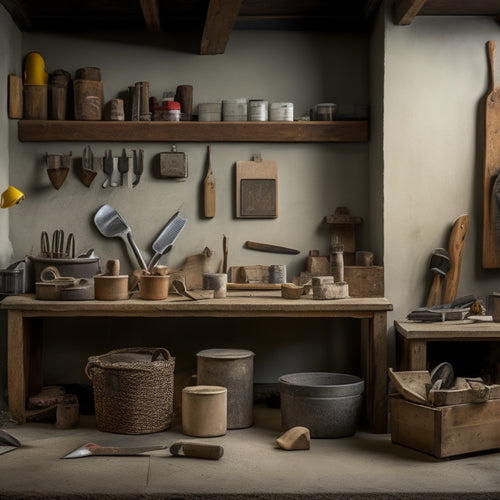
Renovation Tool Checklist for Home Builders
Share
When starting a home building project, you'll need a thorough renovation tool checklist to guarantee efficiency. Begin by gathering essential demolition tools like sledgehammers, pry bars, and reciprocating saws, along with safety gear and workspace preparation materials. Next, acquire masonry tools for concrete blocks, including block hammers and block saws. Don't forget measuring and leveling tools, power tools for heavy lifting, and specialty tools for unique tasks. Safety equipment, tool maintenance, and storage are also vital. By prioritizing these tools, you'll be well-prepared to tackle your project. As you explore the specifics of your renovation, you'll discover the importance of each tool and how to maximize their potential.
Key Takeaways
• A comprehensive renovation tool checklist should include essential tools for demolition, masonry, trowels, measuring, power tools, and hand tools.
• Safety equipment, such as hard hats, safety glasses, respirators, and steel-toed boots, is crucial for protecting home builders from hazards.
• Masonry tools, including block hammers, cold chisel sets, block saws, and pointing trowels, are necessary for working with concrete blocks.
• Measuring and leveling tools, such as tape measures, levels, and squares, ensure accurate measurements and precise leveling.
• Power tools, including rotary hammers, hydraulic jacks, and electric hoists, facilitate heavy lifting and improve renovation efficiency.
Essential Tools for Demolition
As you prepare to tear down walls, rip out flooring, and dismantle fixtures, make certain you have the essential tools for demolition, including a sledgehammer, pry bars, and a reciprocating saw. These tools will allow you to effectively execute various demolition techniques, such as taking down walls, removing flooring, and disassembling fixtures.
When using these tools, it's vital to prioritize safety precautions. Wear protective gear like gloves, safety glasses, and a dust mask to prevent injury from debris and dust. Guarantee a clear workspace by removing any obstacles and securing the area with caution tape. Additionally, turn off the power supply to the area you're working on to avoid electrical shocks.
Remember to also use proper lifting techniques to avoid straining your back. If you're unsure about any aspect of the demolition process, consider consulting a professional or seeking guidance from a trusted resource.
Masonry Tools for Concrete Blocks
With your demolition work underway, you'll likely encounter concrete blocks that require specialized tools to cut, shape, and set. As a home builder, mastering masonry techniques is vital for successful block laying. To achieve professional results, you'll need the right tools for the job.
First, invest in a high-quality block hammer, designed for tapping and shaping blocks. A cold chisel set will also come in handy for splitting and cutting blocks to fit around obstructions. For more precise cuts, consider a block saw or a masonry saw, which can make clean cuts through concrete blocks.
When it comes to setting blocks, a level and a string line will guarantee accurate alignment and plumbness. A pointing trowel is also essential for applying and finishing mortar joints.
Don't forget a good pair of gloves and safety goggles to protect yourself from flying debris and mortar splashes.
Buying Guide for Trowels and Floats
When selecting a trowel, you'll need to contemplate the handle material, as it affects the tool's overall durability and comfort.
You'll also want to think about the type of float blade you need, as different materials and designs are suited to specific tasks.
Trowel Handle Materials Matter
You'll find that trowel handle materials considerably impact the tool's overall performance, durability, and comfort, making it crucial to choose the right one for your specific needs. A well-designed handle can reduce fatigue, improve control, and increase productivity.
When selecting a trowel, consider the following factors:
-
Ergonomics: Look for handles with contoured grips and rounded edges to fit comfortably in your hand, reducing strain and discomfort during extended use.
-
Durability: Handles made from high-quality materials like fiberglass, aluminum, or wood will withstand the rigors of heavy use and resist wear and tear.
-
Balance: A well-balanced handle ensures the trowel's weight is evenly distributed, making it easier to maneuver and control.
Float Blade Types Vary
Selecting the right float blade type is essential to achieving a smooth, even finish, as it directly impacts the quality of your work.
You'll find float blades made from various materials, each suited for specific tasks. For instance, stainless steel blades are ideal for working with epoxy-based materials, while aluminum blades are better suited for finishing concrete. You'll also come across blades made from high-carbon steel, which offer a good balance between durability and flexibility.
When choosing a float blade, you'll need to evaluate the size as well. Float blade sizes typically range from 12 to 24 inches, with smaller blades used for detail work and larger ones for covering larger areas.
You may also need to reflect on the blade's edge type, such as a straight edge or a curved edge, depending on the specific requirements of your project.
By selecting the right float blade type and size, you'll be able to achieve a professional-looking finish that meets your high standards.
Measuring and Leveling Tools
When you're working on a renovation project, having the right measuring and leveling tools is vital for achieving accurate results.
You'll need to guarantee that your walls are straight, floors are level, and corners are square - and that's where these essential tools come in.
Tape Measures Matter
Accurate measurements are essential to any successful renovation project, and a reliable tape measure is the cornerstone of this process. You can't afford to compromise on tape measure accuracy, as it can lead to costly mistakes and delays.
When selecting a tape measure, consider the following key factors:
-
Type: Choose from three main tape measure types: fiberglass, steel, or nylon-coated fiberglass. Fiberglass tapes are ideal for general-purpose measurements, while steel tapes are more durable and suitable for heavy-duty projects.
-
Length: Select a tape measure that can accommodate the longest measurement you'll need to take. Common lengths range from 16 to 33 feet.
-
Certification: Look for tape measures certified by organizations like the National Institute of Standards and Technology (NIST) or the International Organization for Standardization (ISO). This guarantees the tape measure meets strict standards for accuracy and reliability.
Levels Ensure Accuracy
You've got your trusty tape measure in hand, but now it's time to make certain your renovation project stays on the level - literally - with the right measuring and leveling tools.
As a home builder, you know that accuracy is paramount, and that's where levels come in. A level guarantees that your walls, floors, and ceilings are perfectly horizontal and vertical, preventing costly mistakes and structural issues.
When choosing a level, consider a laser level for its advantages, such as increased accuracy and speed. Laser levels project a level line or dot onto a surface, allowing you to quickly check the levelness of an area. Additionally, many laser levels come equipped with level calibration techniques, which make certain that the device remains accurate over time.
Don't skimp on quality when it comes to levels - invest in a high-quality tool that will provide you with precise readings every time. Remember, a level is only as good as its calibration, so make sure to follow the manufacturer's calibration instructions and perform regular checks to make certain accuracy.
Squares Check Angles
In addition to ensuring your renovation project stays level, it's equally essential to verify that all angles are square, and that's where squares come into play, providing a precise way to check and confirm 90-degree angles.
When it comes to squares usage, you'll find that there are various types, including try squares, combination squares, and framing squares, each designed for specific tasks.
Here are three key considerations for using squares in your renovation project:
-
Accurate angle measurement: Squares allow you to verify that your angles are precise, which is critical for ensuring the structural integrity of your project.
-
Versatility: Different types of squares can be used for various applications, from checking small angles to measuring large frames.
-
Precision: Squares provide a reliable way to confirm 90-degree angles, reducing the risk of errors and ensuring a professional finish.
Power Tools for Heavy Lifting
Your renovation project requires power tools that can handle heavy lifting, and a rotary hammer is a must-have for efficiently breaking up concrete, tile, or brick. This tool's high-torque motor and specialized bits make quick work of even the toughest materials.
Next, you'll need a reliable way to lift and maneuver heavy objects. That's where hydraulic jacks and electric hoists come in. Hydraulic jacks provide the brute force you need to lift massive weights, while electric hoists offer precise control and versatility. Whether you're raising a beam or moving a heavy appliance, these tools will get the job done safely and efficiently.
Don't overlook the importance of a high-capacity drill press, either. With its powerful motor and precise control, you'll be able to drill through even the thickest materials with ease.
Hand Tools for Finishing Touches
As the renovation project nears completion, attention shifts to the finer details, and that's where an extensive set of hand tools comes into play.
You'll need a variety of hand tools to guarantee a professional finish. The right hand tool selection is vital for achieving those finishing touches that make a renovation project stand out.
Here are three essential hand tools you shouldn't overlook:
-
Taping knife: For applying and smoothing joint compound, a taping knife is a must-have. Its flexible blade makes it easy to feather edges and create a seamless finish.
-
Putty knife: A putty knife is perfect for filling small holes and imperfections in the wall or trim. Its flat, wide blade allows for smooth, even application of putty or spackling compound.
-
Level: A level guarantees that your finished surfaces are, well, level. Whether you're installing shelves, cabinets, or trim, a level assures a precise and professional finish.
With these hand tools in your arsenal, you'll be able to tackle those finishing touches with confidence and precision, resulting in a renovation project that's truly exceptional.
Safety Equipment Checklist
Make certain you're prepared for any situation by stocking your toolkit with essential safety equipment, such as hard hats, safety glasses, and respirators, to protect yourself from potential hazards on the renovation site. As a home builder, it's vital to prioritize personal protective equipment (PPE) and site safety to guarantee a safe working environment.
Here's a checklist of essential safety equipment to include in your toolkit:
| Safety Equipment | Purpose |
|---|---|
| Hard Hats | Protect head from falling objects and debris |
| Safety Glasses | Shield eyes from flying particles and chemical splashes |
| Respirators | Filter airborne contaminants and pollutants |
| Steel-Toed Boots | Protect feet from heavy objects and sharp edges |
Specialty Tools for Unique Tasks
When you're tackling a renovation project, you'll encounter tasks that require specialized tools to get the job done efficiently and effectively.
You'll need to identify the unique tasks that lie ahead and assemble the right tools for the job, whether it's demolition or precision cutting.
Demolition Tool Essentials
You'll need specialized demolition tools to tackle unique tasks, like removing tile or breaking up concrete, that require more precision and control than traditional demo methods can provide. These tasks demand a higher level of accuracy and finesse to avoid damaging surrounding structures or compromising demolition safety.
To guarantee a successful demolition, consider the following essential tools:
-
Tile scraper: A must-have for removing tile and adhesive without damaging the underlying surface.
-
Concrete breaker: A powerful tool for breaking up concrete slabs, sidewalks, or driveways, allowing for efficient debris removal.
-
Demolition hammer: A versatile tool for breaking up and dismantling structures, featuring a chisel or hammer end for maximum versatility.
When working with these specialized tools, remember to prioritize demolition safety by wearing personal protective equipment, securing the work area, and guaranteeing a clear path for debris removal.
Precision Cutting Solutions
For intricate cuts and precise shaping, specialty tools are essential for tackling unique tasks that require finesse and accuracy beyond traditional cutting methods. You'll need tools that can deliver precise control and versatility to achieve the desired results.
In your arsenal, consider including:
| Tool | Description |
|---|---|
| Laser Cutting Tool | Provides ultra-precise cuts with minimal material waste and heat damage |
| Circular Saws with Specialty Blades | Offers versatility for curved cuts, bevels, and compound miter cuts |
| Jigsaws with Precision Guides | Enables precise curved cuts and intricate shapes in wood, metal, and plastic |
These tools will help you tackle complex projects, such as custom cabinetry, intricate wood carvings, and precision metalwork. By investing in these precision cutting solutions, you'll be able to take your renovation projects to the next level, ensuring accuracy, precision, and exceptional results.
Tool Maintenance and Storage
Properly clean and store your tools after each use to prevent rust, damage, and wear, guaranteeing they remain in top condition for your next project. You'll be surprised how much longer your tools last with regular maintenance.
When it comes to tool cleaning, you'll want to:
-
Wipe down tools with a soft cloth to remove dirt and debris after each use.
-
Use a rust-inhibiting spray on metal tools to prevent corrosion.
-
Regularly sharpen cutting tools to maintain their effectiveness.
In terms of storage solutions, consider investing in a sturdy toolbox or chest with dividers to keep your tools organized and easily accessible.
Label each compartment to guarantee you can quickly find what you need.
Additionally, store your tools in a dry, temperature-controlled environment to prevent damage from extreme temperatures or humidity.
Budgeting for Your Toolbox
As you build your renovation toolkit, allocating a budget for essential tools and equipment is crucial to staying on track and avoiding costly delays.
You'll need to determine how much you're willing to spend on each tool, considering factors like quality, durability, and brand reputation. Start by researching the costs of individual tools and equipment, making a list of must-haves and nice-to-haves. Compare prices across different suppliers to guarantee you're getting the best deals.
When creating your tool budget, consider the long-term benefits of investing in high-quality tools. While they may be more expensive upfront, they'll often last longer and perform better, reducing the need for frequent replacements and repairs.
Conduct a cost comparison to determine which tools offer the best value for your money. Be realistic about your budget constraints and prioritize the most essential tools first.
Frequently Asked Questions
What Is the Best Way to Organize Tools on a Construction Site?
When organizing tools on a construction site, you'll want to prioritize tool storage and site safety.
You should designate specific areas for tool storage, keeping frequently used items easily accessible. Label each storage area clearly and assign a specific place for each tool to prevent loss or misplacement.
This system guarantees tools are readily available, reducing downtime and promoting a safe working environment.
Can I Use a Single Tool for Multiple Renovation Tasks?
Savvy builders like you seek smart solutions to streamline their work.
Can you use a single tool for multiple renovation tasks? Absolutely!
Embracing multi-purpose tools boosts tool versatility, simplifying your workflow.
Invest in a quality oscillating multi-tool, for instance, which can tackle tasks from cutting to grinding.
This clever choice will have you completing projects efficiently, without the hassle of switching between tools.
How Often Should I Replace Worn-Out Tool Accessories?
You should replace worn-out tool accessories regularly to maintain peak performance and prevent damage.
Monitor tool maintenance frequency by tracking usage hours, inspecting for signs of wear like corrosion or cracks, and checking the manufacturer's recommended lifespan.
Look out for accessory lifespan indicators like reduced efficiency, excessive vibration, or unusual noise.
Replace them promptly to guarantee precision and safety in your renovation projects.
Are There Any Eco-Friendly Tool Options for Home Builders?
You're cutting through the noise, looking for eco-friendly options that align with your values.
You'll be thrilled to know that sustainable materials are increasingly being used in tool manufacturing.
Energy-efficient tools, like cordless drills with rechargeable batteries, are also gaining traction.
As you build your dream home, consider opting for tools with minimal environmental impact.
Not only will you reduce your carbon footprint, but you'll also set a new standard for responsible building practices.
Can I Rent Tools Instead of Buying Them for a One-Time Project?
You're wondering if renting tools is a better option than buying them for a one-time project.
Absolutely! Renting tools offers significant advantages, particularly for infrequently used or specialized equipment.
This cost-effective solution saves you from investing in expensive tools that may gather dust afterwards.
Conclusion
As you close the lid on your toolbox, remember that it's not just a collection of metal and wires - it's the key to revealing your vision, a hammer to shape your dreams, and a level to balance your creativity.
With this renovation tool checklist, you're now equipped to build something truly remarkable.
So, go ahead, don your hard hat, and construct a masterpiece that will stand the test of time.
Related Posts
-

Create a Home Renovation Project Timeline in Excel
You can create a detailed home renovation project timeline in Excel by setting up a tailored template with separate w...
-

5 Must-Have Plastering Tools for Safe Renovation
You'll need a range of essential tools to tackle your plastering project safely. Invest in a variety of trowels, incl...
-

3 Beginner-Friendly Tools for Plaster Renovation Success
You'll be glad to know that the three essential tools you need for a successful plaster renovation are the same ones ...


